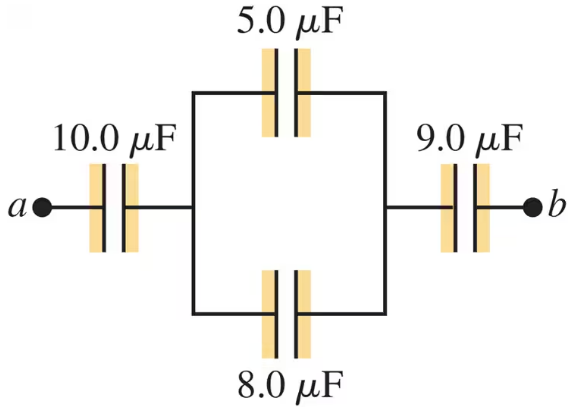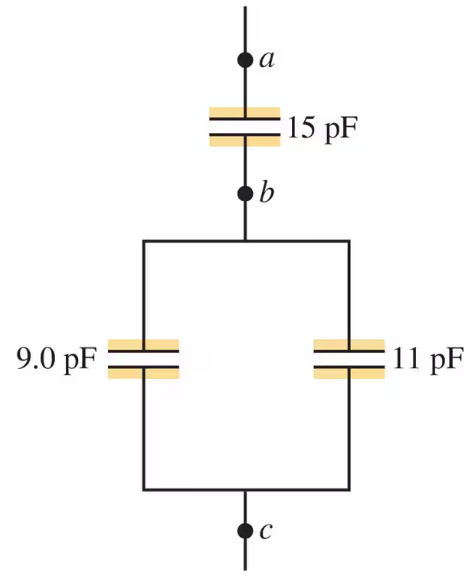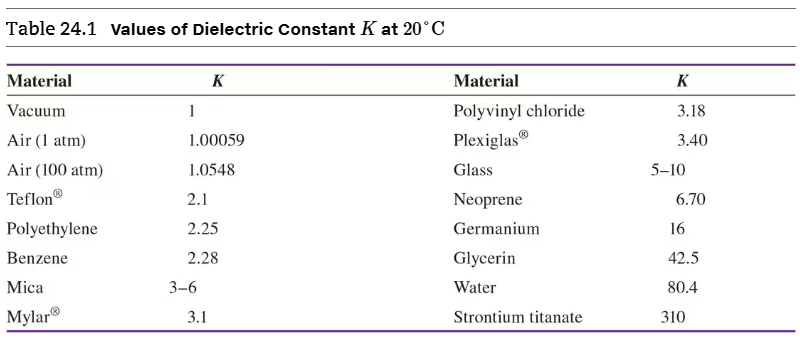 Back
BackProblem 1
The plates of a parallel-plate capacitor are mm apart, and each carries a charge of magnitude nC. The plates are in vacuum. The electric field between the plates has a magnitude of V/m. What is (a) the potential difference between the plates; (b) the area of each plate; (c) the capacitance?
Problem 3
A parallel-plate air capacitor of capacitance pF has a charge of magnitude C on each plate. The plates are mm apart.
(a) What is the potential difference between the plates?
(b) What is the area of each plate?
(c) What is the electric field magnitude between the plates?
(d) What is the surface charge density on each plate?
Problem 4
A -F parallel-plate capacitor is connected to a V battery. After the capacitor is fully charged, the battery is disconnected without loss of any of the charge on the plates.
(a) A voltmeter is connected across the two plates without discharging them. What does it read?
(b) What would the voltmeter read if (i) the plate separation were doubled; (ii) the radius of each plate were doubled but their separation was unchanged?
Problem 7
A parallel-plate air capacitor is to store charge of magnitude pC on each plate when the potential difference between the plates is V.
(a) If the area of each plate is cm2, what is the separation between the plates?
(b) If the separation between the two plates is double the value calculated in part (a), what potential difference is required for the capacitor to store charge of magnitude pC on each plate?
Problem 9
A capacitor is made from two hollow, coaxial, iron cylinders, one inside the other. The inner cylinder is negatively charged and the outer is positively charged; the magnitude of the charge on each is pC. The inner cylinder has radius mm, the outer one has radius mm, and the length of each cylinder is cm.
(a) What is the capacitance?
(b) What applied potential difference is necessary to produce these charges on the cylinders?
Problem 11
A spherical capacitor contains a charge of nC when connected to a potential difference of V. If its plates are separated by vacuum and the inner radius of the outer shell is cm, calculate: (a) the capacitance; (b) the radius of the inner sphere; (c) the electric field just outside the surface of the inner sphere.
Problem 14b
Figure E shows a system of four capacitors, where the potential difference across ab is V. How much charge is stored by this combination of capacitors?
Problem 14c
Figure E shows a system of four capacitors, where the potential difference across ab is V. How much charge is stored in each of the -F and the -F capacitors?
Problem 16a
For the system of capacitors shown in Fig. E, find the equivalent capacitance between and .
Problem 20
In Fig. E, F, F, and F. The capacitor network is connected to an applied potential .
(a) After the charges on the capacitors have reached their final values, the charge on is mC. What are the charges on capacitors and ?
(b) What is the applied voltage ?

Problem 23
A -F, parallel-plate, air capacitor has a plate separation of mm and is charged to a potential difference of V. Calculate the energy density in the region between the plates, in units of J/m3.
Problem 24.24
A parallel-plate air capacitor has a capacitance of 920 pF. The charge on each plate is 3.90 uC. (a) What is the potential difference between the plates? (b) If the charge is kept constant, what will be the potential difference if the plate separation is doubled? (c) How much work is required to double the separation?
Problem 25
An air capacitor is made from two flat parallel plates mm apart. The magnitude of charge on each plate is C when the potential difference is V.
(a) What is the capacitance?
(b) What is the area of each plate?
(c) What maximum voltage can be applied without dielectric breakdown? (Dielectric breakdown for air occurs at an electric-field strength of V/m.)
(d) When the charge is C, what total energy is stored?
Problem 27
You have two identical capacitors and an external potential source.
(a) Compare the total energy stored in the capacitors when they are connected to the applied potential in series and in parallel.
(b) Compare the maximum amount of charge stored in each case.
(c) Energy storage in a capacitor can be limited by the maximum electric field between the plates. What is the ratio of the electric field for the series and parallel combinations?
Problem 32
A parallel-plate capacitor has capacitance pF when there is air between the plates. The separation between the plates is mm.
(a) What is the maximum magnitude of charge that can be placed on each plate if the electric field in the region between the plates is not to exceed V/m?
(b) A dielectric with is inserted between the plates of the capacitor, completely filling the volume between the plates. Now what is the maximum magnitude of charge on each plate if the electric field between the plates is not to exceed V/m?
Problem 39
A constant potential difference of V is maintained between the terminals of a -F, parallel-plate, air capacitor.
(a) A sheet of Mylar is inserted between the plates of the capacitor, completely filling the space between the plates. When this is done, how much additional charge flows onto the positive plate of the capacitor (see Table )?
(b) What is the total induced charge on either face of the Mylar sheet?
(c) What effect does the Mylar sheet have on the electric field between the plates? Explain how you can reconcile this with the increase in charge on the plates, which acts to increase the electric field.
Problem 40
Polystyrene has dielectric constant and dielectric strength V/m. A piece of polystyrene is used as a dielectric in a parallel-plate capacitor, filling the volume between the plates.
(a) When the electric field between the plates is % of the dielectric strength, what is the energy density of the stored?
(b) When the capacitor is connected to a battery with voltage V, the electric field between the plates is of the dielectric strength. What is the area of each plate if the capacitor stores mJ of energy under these conditions?
Problem 41
When a -nF air capacitor ( nF = F) is connected to a power supply, the energy stored in the capacitor is J. While the capacitor is kept connected to the power supply, a slab of dielectric is inserted that completely fills the space between the plates. This increases the stored energy by J.
(a) What is the potential difference between the capacitor plates?
(b) What is the dielectric constant of the slab?



